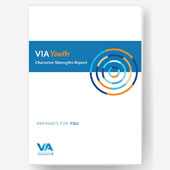The Appeal of Positive Psychology
Teachers are busy! There is so much to pack into a school day that many educators aren't ready to add another "thing" to their list. But, a few years ago I discovered the science of positive psychology (If you aren't familiar watch this great 5-minute Positive Psychology whiteboard video). Traditional psychology typically looks at what is wrong with people (problems and ways to deal with them), while positive psychology looks at what is right with individuals (what makes people flourish). I was fascinated by this evidence-based science and pondered how I could apply it to my classroom in an easy way.
One of the most interesting areas in positive psychology is exploring character strengths such as honesty, zest, love of learning, perseverance, gratitude, and curiosity. I liked the idea of focusing on students’ strengths instead of their weaknesses, because after seven years as an EAP instructor I felt that with red pen in hand, my job was to point out errors or deficits in writing. And students are much more than their writing skills! I decided to use the VIA Youth Character Strengths Survey with my students in hopes to motivate them more but had no idea how big the impact of taking a 10-minute survey would be.
4 Step Plan To Integrate Strengths
1. Pre-writing activity. First we watched the video The Science of Character in class. Students discussed the content in small groups exploring such questions as, “How are character strengths like super-powers? What do you think your top strengths might be?”
2. The survey. The VIA Survey takes about 10 minutes. I set up a free VIA Pro site with a designated link for the survey for each class. This way I could verify when the students completed the survey and I would get their results added to my VIA account.
3. Face-to-face interviews. I set up a schedule with 10-minute time slots to talk to students about their top five character strengths and how they use them specifically as a student. I created a form for this task which they were required to complete and bring to the interview. Reflecting on the survey results before the interview and being asked questions during the interview was part of a pre-writing exercise for their writing assignment.
4. Writing assignment. Students were required to write a 5-paragraph essay about how their top three character strengths have impacted their life. Although the top five are considered Signature Strengths (and the ones that are most easily and often used), choosing just three made it easier for the essay format.
Small Changes, Big Results
Meeting forty students in one class requires time that we often do not have but I wanted to be able to personally connect with each student. During the interviews, I noticed two things.
First, when I asked each student to tell me about their top five character strengths and how they demonstrate them as a student, they immediately came to life! Normally in my EAP classes students are very quiet, but the same learners beamed and spoke with a sense of excitement as they talked about their strengths.
The second change was in me. When I looked out at the sea of student faces after the interviews, I saw their strengths instead of thinking about their writing skills. For example, I had one student who constantly asked questions. When I learned that two of his top five strengths were curiosity and leadership, it made complete sense. In other words, instead of seeing him as annoying I now perceived him as inquisitive and asking questions that others might be afraid to ask. Another student, who had hounded me via email for two weeks about making up a missed assignment, had fairness as his top strength. He felt that my denial of his request was unfair and that made sense to me, so we talked one day after class and I changed my mind about the make-up test.
Normally I can’t say that I enjoy reading and grading forty essays, but I was actually excited about reading that particular pile of papers. Students had learned what they were good at and what was positive about themselves. Hopefully this knowledge and awareness will have a lasting effect on their success as learners and out in the labour force.
I’d like to share with you a few comments from the essays written by my students.
"In conclusion, identifying and building on your own unique character strengths can help make a better and happier person. I agree with the top three results of my VIA Character Strengths Survey (love, fairness, and kindness). Although I suppose I was aware of these traits, the survey made me stop and think about my character. In the future I will use these character strengths to bring out the best in me and help me to achieve the goals I set for my life. After all, it’s what inside a person that counts.”
“The three character strengths of curiosity, love of learning, and leadership have aided me by providing me access to work opportunities, helping my performance in school, seek out learning opportunities, and increase the quality of my interpersonal relationships at school.”
“My top three character strengths are Love, Prudence and Teamwork. I was not surprised to discover what they turned out to be. I would not even have changed the order in which they were given. It was reassuring to know what I thought I already knew.”
Why Use Character Strengths?
There are many reasons why it could be a good idea, but I think most importantly students should learn about their strengths and reflect on how they can use them (or how they have been using them in the past) to achieve results inside and outside of school. We know that our language learners can feel frustrated in their ability to learn English, so focusing on strengths could give them confidence. It is important to remember that all character strengths have downsides if overused, so that should be discussed as well. For example, my own top character strength is Appreciation for Beauty and Excellence but its overuse results in perfectionism! Another example would be the overuse of curiosity – too much of it may mean that the person never gets anything done because they are so distracted by learning about everything around them.
Overall, using our character strengths makes us feel happier, more confident, increases our energy, lessens our stress, helps us to achieve goals and grow as individuals. What teacher doesn’t want that for his/her students!
This article was originally published on the iTDi Blog and is republished permission.


